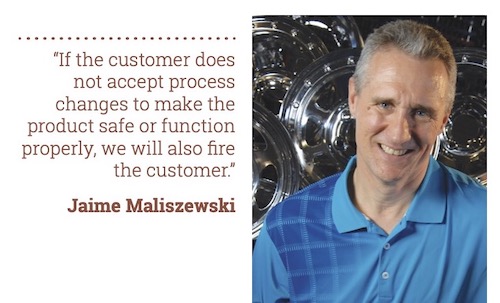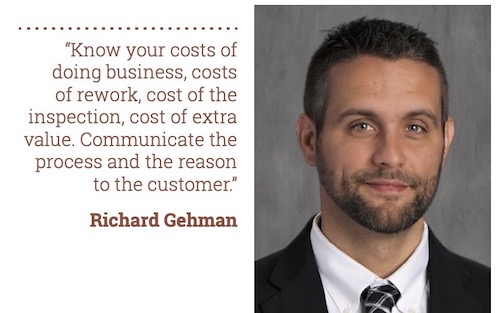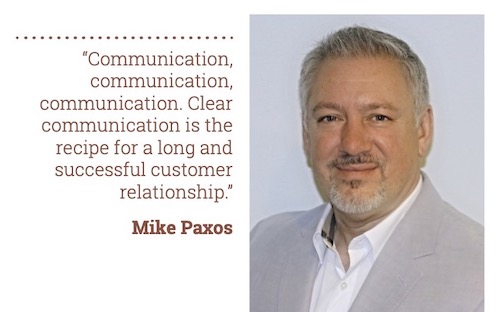Rick Hunter, owner of A.M. Metal Finishing in Orlando, says he first heard the term ‘fire your customer’ about 10 years ago while on a trip to Europe with fellow anodizers.
He thought it was a novel idea and gave it a lot of thought on the flight home.
“I thought this is something that we should do because we can’t be all things to all people,” Hunter says. “We did fire some customers at that time, but they did very minimal volume and had specialty chemicals you needed to use for that finish that we bought just for them.”
Hunter also terminated customers who didn’t pay within their credit terms.
“We weren’t going to chase our money any longer,” he says. “That idea worked well, so we continued firing customers.”
Letting go of marginal customers — or ‘firing’ them as the term goes – is picking up steam in the coating and finishing business as demand increases and the patience of some owners decreases.
Dallas Cooley, vice president and owner at Georgia Powder Coating, says that in his experience, letting go of a customer has to meet three criteria.
“The business is not profitable, the customer has unrealistic expectations, or the customer is verbally abusive to our staff,” says Cooley. “The last thing you want to do is create a culture of firing customers every time a challenge arises — that’s a formula for bankruptcy.”
The Process of Letting Go
FinishingAndCoating.com surveyed several owners and managers in the industry to see what goes into letting go of a customer and what are the best tips and practices to get it done.
 Dallas Cooley, George Powder Coating“If a customer is too demanding, abusive, or is not producing a profit, then maybe it is time to re-evaluate your business relationship,” says Keith Eidschun, owner of Freedom Metal Finishing in Clearwater, Florida.
Dallas Cooley, George Powder Coating“If a customer is too demanding, abusive, or is not producing a profit, then maybe it is time to re-evaluate your business relationship,” says Keith Eidschun, owner of Freedom Metal Finishing in Clearwater, Florida.
“Through the years, we notice a pattern that some customers are always complaining and were taking up an enormous amount of company time so,” he says. “They never seemed to be pleased no matter the level of effort that was involved to make it happen.”
Some shops say they have never had to terminate a customer. Mark Mortensen, president of All-Color Powder Coating in Oregon, Wisconsin, says that his business is similar to many others in that 75% to 80% of their business is from their top 10 or so customers, and he is hesitant to show a low-volume customer to the door.
“I have always been reluctant to ‘fire’ one of these customers because you just don’t know which one will come up with the next big project,” he says. “We’ve grown our business via word-of-mouth over the last 25 years and pride ourselves on providing all customers a high-quality product with exceptional customer service at a fair price. That said, we are not afraid to charge for that, especially on lower volume and more intricate jobs.”
Addressing Economical Concerns
 But Kurt Weamer, Director of Sales and Marketing at Minnesota’s Wolkerstorfer Co., says if a business relationship is not in both parties’ best interest economically, then it needs to be addressed.
But Kurt Weamer, Director of Sales and Marketing at Minnesota’s Wolkerstorfer Co., says if a business relationship is not in both parties’ best interest economically, then it needs to be addressed.
“Unlike other ‘personal’ situations, this is a business decision based on facts,” he says. “Work that is not profitable — or customers that have a lot of ‘hidden costs’ — are candidates for termination.”
Weamer says those hidden costs include unrealistic scheduling demands, paperwork or ongoing documentation issues, and overreaching quality requirements that were not disclosed during the quoting process.
“Fortunately, we do not do this often because of the vetting and quoting process we use to weed out the bad opportunities,” he says.
Jeff Smith, president and owner of Electro-Spec in Franklin, Indiana, says his shop is starting to utilize a ‘plateability matrix’ for customers to scores a variety of items, including customer payment, communication, specifications, potential volumes/sales, and even quality requirements, part geometry, and type of part.
“Each of these items is scored for ‘plateability’ to see if it is something that we feel is worth the risk to devote the time, energy, and resources to moving forward with a customer or project,” Smith says. “We are still in the very early stages of this, but it is a nice tool to put things into perspective and not be focused solely on sales. For example, when the quality requirements may not be consistently achievable.”
How to Fire A Customer
 The most difficult aspect of terminating a relationship with a customer is how to do it.
The most difficult aspect of terminating a relationship with a customer is how to do it.
“Always, always, always try to work out the problem,” says Jaime Maliszewski, owner of Milwaukee’s Reliable Plating Works and Elite Finishing. “This has to be a last resort and not a quick emotional option.”
Mike Paxos, owner of Lustrous Metal Coatings in Canton, Ohio, says having an open relationship with a customer is the best way to head off any problems.
“Communication, communication, communication,” he says. “Clear communication is the recipe for a long and successful customer relationship.”
Jamie Olson, vice president at Apex Anodizing in Orgon, says they often take a more direct approach to let a customer know the relationship is over.
“The rip-the-band-aid-off method is always the best,” Olson says. “Tell them why and what the issues are. A lot of times, this will actually serve as a wakeup call, and they will want to work with us.”
Allan Phillips, owner of The Metal Finishing Center in Ontario, Canada, meanwhile, has a more congenial route to severing ties.
“Follow good parenting practices,” Phillips says.
FinishingAndCoating.com asked several leading facilities several questions related to ‘firing’ a customer, including:
- Who do you determine needs to be ‘fired?’
- How often do you do it?
- What criteria do you use to let go of a customer?
- How do you go about notifying them?
- Tips, techniques, and best practices?
Here are some of the responses from these leading show owners:
Who do you determine needs to be ‘fired?’
 Jeff Smith, Electro-Spec: “We focus on ‘value through innovation,’ and as a value-added business, we tend to fall on the side of trying to make the impossible possible like a lot of companies do. In doing that, we get involved initially in projects and discussions with engineers that seem to be fairly reasonable and attainable. But, we have had some projects where the expectations for quality and acceptance were either not entirely clear or increasingly difficult to achieve on a consistent basis. Knowing that we will wrap up a lot of engineering time, samples, and possible scrap in trying to meet the customer’s requirements, the ‘value-added’ concept gets reviewed again to see what value it adds to our business. Sometimes, the risks and costs simply outweigh the rewards, and you have no choice but to politely walk away from customers and projects.”
Jeff Smith, Electro-Spec: “We focus on ‘value through innovation,’ and as a value-added business, we tend to fall on the side of trying to make the impossible possible like a lot of companies do. In doing that, we get involved initially in projects and discussions with engineers that seem to be fairly reasonable and attainable. But, we have had some projects where the expectations for quality and acceptance were either not entirely clear or increasingly difficult to achieve on a consistent basis. Knowing that we will wrap up a lot of engineering time, samples, and possible scrap in trying to meet the customer’s requirements, the ‘value-added’ concept gets reviewed again to see what value it adds to our business. Sometimes, the risks and costs simply outweigh the rewards, and you have no choice but to politely walk away from customers and projects.”
Mike Paxos, Lustrous Metal Coatings: “We recognize the loyalty our customers have in us. While we do not ‘grade’ or make an annual evaluation of our customers, the overall determination is based on profitability. Slow-pay customers are a normal red flag for non-desirable customers, but we do everything possible to work with them to help them out of the situation they may be in as we have a great value for all customers. Often, slow-pay indicates that a customer may have financial issues and — while we are sympathetic to their situation — at the end of the day, we must protect our business. Customers that repeatedly miss scheduled production times also raise red flags since they disrupt our productivity and can create unrecoverable costs.”
Richard Gehman, Keystone Koating: “In my opinion, a customer who needs to be fired is one who seems impossible to please and is unprofitable. We value feedback from our customers and will adjust to their requests. If the customer routinely has issues, and no matter what we do, we cannot meet their expectations and are not profitable, it is time to part ways. Often the customers we have parted ways with are ones that also do not share our same values.”
Dallas Cooley, Georgia Powder Coating: “In our experience, it has been for three criteria: the business is not profitable, the customer has unrealistic expectations, or the customer is verbally abusive to our staff. In the event the business is not profitable, every attempt is made to renegotiate the project before ‘firing’ or ending the business. Similarly, with unrealistic expectations, ‘firing’ only occurs after all attempts have been made to educate the customer regarding any impractical demands. Firings for verbal abuse have unfortunately been necessary and require a much more refined process. You cannot proclaim ‘our people are first’ from the podium and then turn a blind eye to customer abuse because it’s profitable; by doing so, you are actually saying ‘the money is first,’ and that’s a recipe for disaster.”
Jamie Olson, Apex Anodizing: “It really comes down to their willingness to learn and work with us. I hear the term ‘you just dip it in a basket; what’s so hard about it’ so often that the oversimplification shows a lack of respect for the industry. If someone is not willing to understand what lead times are, why taking the time and not ‘skipping steps’ is important, and the science behind what we do, then it’s best to part ways before you lose a lot of time and money.”
Kim Scott, Maui Powder Works: “I look for the language they use. You can tell when they use certain keywords or phrases like ‘can’t you …’ or “I’m just ...’”
Allan Phillips, The Metal Finishing Center: “We approach customers who verbally abuse or take advantage of our staff and systems and request modification of their behavior. We do not accept bad behavior from staff, customers, or suppliers. If the behavior persists, we ask them to leave. Also, of course, customers who consistently pay very late are given options to pay on time. If they don’t meet the requirements, we suggest they find another supplier who may be more amenable to their payment pattern.”
Jaime Maliszewski, Reliable Plating Works, and Elite Finishing: “The easiest reason to fire a customer is if they horribly mistreat my employees. There is a line where being an angry customer that is upset or being a poor excuse for a human being is crossed and is not acceptable. The second reason that can get a customer fired is an entire product line that is running at a loss due to issues outside of our control that the customer is not willing to accept a price increase or process change to resolve the issue. The only other reason we have ever fired a customer is that they wanted us to use a plating process that was not compatible with the end use of the part, and it would have made the part not function as required or made it unsafe. In any of these situations, the information comes to me, and I contact the customer to come up with a satisfactory resolution. If none can be made, then the customer is fired, but not until every possible option is looked into.”
How often do you let a customer know you’ll no longer be taking their business?
 Allan Phillips, The Metal Finishing Center: “We make it clear at the outset of any relationship —staff, customers, suppliers — what our core values are and the requirements to adhere to those values, and the consequences. We find that we rarely have to follow through on discipline - maybe once per year for each of staff, customers, and suppliers. It is always a regret when we do it. Did we ourselves do something wrong to encourage the behavior?”
Allan Phillips, The Metal Finishing Center: “We make it clear at the outset of any relationship —staff, customers, suppliers — what our core values are and the requirements to adhere to those values, and the consequences. We find that we rarely have to follow through on discipline - maybe once per year for each of staff, customers, and suppliers. It is always a regret when we do it. Did we ourselves do something wrong to encourage the behavior?”
Jaime Maliszewski, Reliable Plating Works, and Elite Finishing: “We have not fired a customer in a few years, and it has been rare in the 20-plus years I have been running the company. We have done it less than a handful of times that I can remember.”
Richard Gehman, Keystone Koating: “We rarely fire a customer. Before we discontinue working for them all together, we would discontinue doing a product or product group. This might happen once or twice every five years.”
Dallas Cooley, Georgia Powder Coating: “As reservedly as possible, only after careful prayer and consideration as to whether it is indeed the best decision for the organization. The last thing you want to do is create a culture of firing customers every time a challenge arises — that’s a formula for bankruptcy. Extreme caution and team collaboration must be used to confirm that firing is indeed the last resort. The decision should be difficult and should give you great pause and concern. The right decision is not always easy to make but never complain about the behavior you allow.”
Jeff Smith, Electro-Spec: “Thankfully, not too often. I would say that we have had to do this a handful of times over the past 10 years.”
Mike Paxos, Lustrous Metal Coatings: “We are loyal to our customers, maybe to a fault. We have been fortunate in that we truly build partnerships with our customers, so we are in constant communication with them. When there is an issue, we try to limit the damage prior to it escalating and getting out of hand. If the communications are not satisfactory in correcting the problem, it becomes necessary to terminate the relationship. Firing a customer is a last resort.”
Jamie Olson, Apex Anodizing: “Rarely, maybe a couple of times a year. We really try to avoid it as at the end of the day we are a customer service business, and we want to make sure we are giving the best service possible, but sometimes it’s just unavoidable.”
Kim Scott, Maui Powder Works: “Unfortunately, since COVID 19, we are seeing uncertainty from that being reflected in decision making more and more often now.”
What criteria do you use to let go of a customer?
 Allan Phillips, The Metal Finishing Center: “R-E-S-P-E-C-T.”
Allan Phillips, The Metal Finishing Center: “R-E-S-P-E-C-T.”
Jaime Maliszewski, Reliable Plating Works, and Elite Finishing: “In the situation where the customer used unacceptable language with one or more of our employees, we see if there is any remorse from the customer in question, any provocation from our employee, or if a superior in the customer’s organization takes action to correct the situation. If the customer takes action to correct this situation — or we were at fault — we will not fire the customer. But if a solution is not corrected, that customer will be fired. If the customer refuses to accept a price increase and will not accept any other cost-saving measures that are available, they will be fired. If the customer does not accept process changes to make the product safe or function properly, we will also fire the customer.”
Jeff Smith, Electro-Spec: “Usually there is a long list of part numbers, purchase orders, emails, corrective actions or other documentation that is reviewed and cited in some fashion with the customer as to why we are making the decision to part ways. As is the case in plating, typically, the cost of the part far exceeds the cost of the plating, so there are inherent risks that you can no longer accept in order to run a profitable business. We do track profitability by customer as well to understand who are our ‘best’ customers are as compared to the highest revenue customers. Many times our best customers aren’t necessarily who we do the most business with.”
Mike Paxos, Lustrous Metal Coatings: “Continued disregard for payment terms and production schedules are the main criteria, along with management unable or unwilling to rectify the problem.”
Richard Gehman, Keystone Koating: “We will do everything we can to meet their expectations. If we can figure out a realistic, sustainable process that is profitable, we will keep them. If we cannot figure out a realistic, sustainable process, we will have to decline the work.”
Jamie Olson, Apex Anodizing: “It’s always judgment-based and depends on history. If we have done business for years and someone new comes in and changes things, we’ll work really hard to train them to understand what we do and how we do it. But if it’s a newer account that is a constant problem, you normally tell pretty early into conversations that the ‘juice is not worth the squeeze.’”
Kim Scott, Maui Powder Works: “This is more psychological than anything else, but primarily it’s how they communicate. This is different from the typical questions you get from most inquiries. Like is it on multiple platforms or one way? Email, phone, text. Example: do they ask for the same salesperson every time, or do they ask the same question to multiple people hoping for a different answer till they get what they want? We’ve found the more different access points they use, the more they are not our client. It sounds like a weird correlation, but I dare many to consider this. Also, the quality of the platform is just as important. For instance, calls and emails seem to draw higher quality leads/sales clients; whereas, social media, like Instagram and FB messenger less so.”
How do you go about notifying the customer that it is over?
 Jeff Smith, Electro-Spec: “In most cases, it starts with a purchase order (pricing/delivery) or quality discrepancy in some fashion that we have consistently disputed. If there is no leniency provided by the customer and we have exhausted all measures at either satisfying them or finding a way to make it worthwhile and profitable to continue the relationship, then we either conduct a conference call or send a letter of explanation for our decision.”
Jeff Smith, Electro-Spec: “In most cases, it starts with a purchase order (pricing/delivery) or quality discrepancy in some fashion that we have consistently disputed. If there is no leniency provided by the customer and we have exhausted all measures at either satisfying them or finding a way to make it worthwhile and profitable to continue the relationship, then we either conduct a conference call or send a letter of explanation for our decision.”
Kim Scott, Maui Powder Works: “We politely decline, but one time we actually had to say ‘Get out of my shop and don’t come back!’”
Allan Phillips, The Metal Finishing Center: “We personally approach them about their behavior issues with examples and suggest what might be a better option. If there is no movement to change, we ask them to go elsewhere. But we make it clear at the outset of any relationship what the values are, and the consequences are, and we do not allow slack at the very outset in response to behavioral problems, so there should be no surprise when there is a consequence.”
Mike Paxos, Lustrous Metal Coatings: “Management is already aware of issues. When management is made aware, a possible remedy should include the need to seek another plater if they cannot meet our expectations.”
Richard Gehman, Keystone Koating: “Most times for us we will figure out the process we need and the margin required; usually it is higher to account for more frequent rework. We will explain why the price is needed to meet their requirements. The customer usually says, ‘thanks, but no thanks’ and takes the work elsewhere. We can then turn our energy back to profitable work.”
Dallas Cooley, Georgia Powder Coating: “I’ve found the ‘it’s not you, it’s me’ approach — which I was often the recipient of in grade school — works best. The conversation might go something like this: ‘We work hard on systems to produce happy results; perhaps we have failed you by false pretenses of our obligations, and for that I am sorry. I feel we are setting all of us up for failure to continue.’ Preferably, this conversation is in a calm manner after the issue at hand has been settled to the best of our ability. We have also experienced customers agreeing to change behavior as a result of such a conversation, although I would not use it in attempts to bluff.”
Jamie Olson, Apex Anodizing: “The rip-the-band-aid-off method is always the best; tell them why and what the issues are. A lot of times, this will actually serve as a wakeup call, and they will want to work with us.”
Jaime Maliszewski, Reliable Plating Works, and Elite Finishing: “They are notified with a phone call from me explaining the situation and a written letter follows that explains that we will no longer accept orders from their company.”
Any tips, techniques, best practices you would offer other shops?
Mike Paxos, Lustrous Metal Coatings: “Communication, communication, communication. Clear communication is the recipe for a long and successful customer relationship.”
Richard Gehman, Keystone Koating: “Know your costs. Know your costs of doing business, costs of rework, cost of the inspection, cost of extra value. Communicate the process and the reason to the customer. You may have to explain why the process is needed to meet their expectations. Most importantly, for me, if I know the customer has a different set of values — price over quality or profit over people — I will be quicker to part ways with them. I will look for evidence of that throughout the conversations and not worry about losing a customer. I can then spend my time developing relationships with customers that share our values.”
Dallas Cooley, Georgia Powder Coating: “If you have made the correct decision, the morale and overall mood of the organization will be noticeable. Work will proceed with more vigor, knowing leadership was able to make the tough decision for the betterment of the organization. ‘Our people are first’ will no longer be a slogan but an action. Combat the culture of firing customers by always trying to speak well of them internally and doing your absolute best not to burn a bridge. Sometimes new contacts and leadership can occur, and you don’t want the breakup to hinder new opportunities since manufacturing is a small world after all.”
Jeff Smith, Electro-Spec: “We are actually in the process of designing a ‘plateability matrix.’ This scores a variety of metrics that start with customer payment, communication, specifications, potential volumes/sales, and proceeds to quality requirements, part geometry, type of part —very large, very small, fragile, parts that nest together, etc. — part material and the process to plate the part, such as barrel, rack, wire, vibratory, etc. Each of these items is scored for ‘plateability’ to see if it is something that we feel is worth the risk to devote the time, energy, and resources to moving forward with a customer or project. We are still in the very early stages of this, but it is a nice tool to put things into perspective and not be focused solely on the sales, for example, when the quality requirements may not be consistently achievable.”
Jamie Olson, Apex Anodizing: “My best tip is not to overreact to someone as they just might not know what we do; take the time to work with them and help them understand the industry. You’ll know when it’s a lost cause; some people are bound to jump around from shop to shop and will always blame platers for their issues. Those are the ones that won’t listen to our advice and will always say things like ‘I’ll just put in my line, it’s not like it’s hard.’”
Kim Scott, Maui Powder Works: “This is where your marketing efforts combined with a clear definition of your client profile can really eliminate or minimize having to fire your client in the first place. You can create content specific to what your service does for that perfect client.”
Allan Phillips, The Metal Finishing Center: “Follow good parenting practices.”
Jaime Maliszewski, Reliable Plating Works, and Elite Finishing: “Always, always, always try to work out the problem, as this has to be a last resort and not a quick emotional option. Make sure you look at the situation from both sides and make a clear non-emotional decision. Once the decision is made, be clear and to the point with your customer making sure the highest-ranking person that you deal with is involved. Treat the situation as if you were dealing with firing a long term employee.”



































